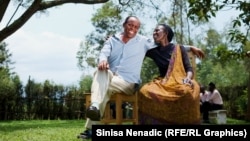Sitting beside her neighbor Karenzi Nasson, Margaret Murekatete is relaxed, laughing, in Rukara, eastern Rwanda. But it wasn't always this way.
"When I saw his face before, I felt like screaming and hiding. I lived like an animal -- I didn’t go to treatments," she says. A survivor of the genocide, Margaret lives in a reconciliation village, attending trainings and activities designed to bring together victims and perpetrators of the 1994 atrocities.
"I was a man with a choice," Karenzi Nasson admits. On April 9, 1994, he was among the Hutu attackers who stormed a local church, slaughtering Tutsis who had sought refuge within its walls. Around 10,000 people were murdered there and in the surrounding area. Across Rwanda, nearly 1 million Tutsis were killed in just 100 days.
Nasson fled to Tanzania but eventually returned to Rwanda, confessed his crimes, and served seven years in prison. It was behind bars that the weight of his actions fully sank in.
"Genocide is the greatest crime people like denying. It is rare to find someone who truly believes they committed genocide," he reflects. Asking Margaret for forgiveness, he says, felt like a battle within himself.
"If she doesn’t kill me, she will forgive me."
Albert Rutikanga had helped build this reconciliation village. His parents were, too, killed in the church.
"Fifteen years ago, I lived with anger and bitterness. I suffered. In 2015 I participated in a training organized by Aegis Trust, and that helped me to overcome anger. I wanted then to see what can I do for the community where I was born", says Rutikanga, who then went on and founded an NGO Peace Education Initiative Rwanda.
The path was long. Rutikanga admits that no one, not the victims nor perpetrators, trusted his intentions at the beginning.
Facing The Past
Some 8,000 kilometers away, in a village near Srebrenica, Bosnia-Herzegovina, Emin Bektic lives alongside a dozen other elderly people. Jasenova is one of the few villages where Bosniaks and Serbs live side by side after the 1995 Srebrenica genocide in which more than 8,000 Muslim men and boys were killed by Bosnian Serb forces.
"There's no one here. Everything's deserted. Everyone's gone. Some days, you just want to see a person -- it doesn't matter if they're Bosniak or Serb," he told RFE/RL.
Emin returned to Srebrenica after spending several years in Germany following the war. His four daughters now live in the capital, Sarajevo.
Neither in the capital nor in other parts of the country do students learn about the Srebrenica genocide. Due to the complex government structure established by the Dayton Peace Accords, which ended the war, Bosnia-Herzegovina has no state-level education ministry.
Curricula are decided at the local level. In the Federation, one of the two administrative units in Bosnia, some schools visit the genocide memorial and are taught about the past by willing teachers. But in Republika Srpska, the genocide is still denied.
"A professor can't do it alone. We need a team of people around us to figure out how best to present these lessons to students," says Alma Berbic, a high-school teacher in Tuzla, a city about 100 kilometers from Srebrenica.
As a result, it's not uncommon for students to learn about the Rwandan genocide but not the one that happened in their own country.
In contrast, Rwandan schools began teaching about the genocide as early as elementary school. It took over a decade to develop the curriculum. The early lessons are basic, with more complex topics and atrocities introduced at the university level.
Some of the lessons were developed by the Kigali Genocide Memorial in 2015. Joan Murungi, head of curriculum in Rwanda, explains: "It's a journey. I can't tell you we are 100 percent right."
A visit to the Kigali Genocide Memorial is mandatory for students.
One reason survivors and perpetrators of the genocide in Rwanda live in such close proximity today is that most people had no choice but to return to their original homes. As a result, there is no village or district where only survivors or only perpetrators live, locals tell RFE/RL.
Vincent Sezibera, a professor and psychologist in Rwanda, explains that in the years following the genocide, nearly 2 million people were tried in local courts. To be allowed to return home, many of them had to ask for forgiveness, confess their crimes, and -- if they had knowledge -- reveal the locations of mass graves.
What was strongly emphasized throughout the process, Sezibera adds, was that there is no such thing as collective guilt.
"Even though the militia and the propaganda behind the genocide called on all Hutus to kill all Tutsis, we must remain cautious and assign responsibility individually," he says. "We should say: Josef was involved in the killings. And we must be careful not to include even Josef's children -- because the child of a killer is not a killer."
In contrast, for years, survivor groups in Srebrenica have been urging anyone with information to come forward and reveal the locations of mass graves. More than 1,000 victims of the genocide are still missing.
For those who have returned to Srebrenica, life remains difficult. Numerous testimonies presented at The Hague Tribunal describe perpetrators still living in the town, where they continue to cross paths with survivors yet have never been held accountable for their crimes.
Most people never returned. Before the war, the Srebrenica municipality had a population of around 36,000. Today, that number is about 5,000, according to municipal data.
The drive from rainy Srebrenica to the nearest bigger city, Tuzla, takes just under two hours. For the first 20 minutes, the road winds through darkness. The faint outlines of houses emerge -- silent, their windows unlit.













